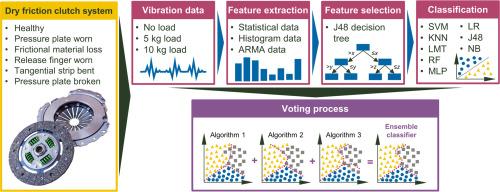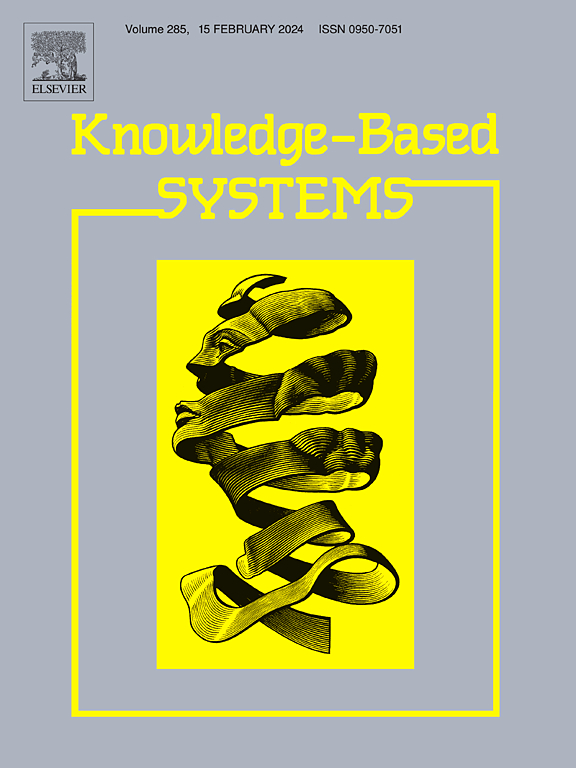通过机器学习对三机械系统进行智能故障诊断:多特征提取和集合投票法
IF 7.6
1区 计算机科学
Q1 COMPUTER SCIENCE, ARTIFICIAL INTELLIGENCE
引用次数: 0
摘要
及时发现故障对于防止离合器片磨损和摩擦材料过度降解等问题、提高燃油效率和延长离合器使用寿命至关重要。本研究的重点是利用机器学习(ML)技术对干摩擦离合器系统进行早期故障诊断。在不同负载和故障条件下对振动数据进行分析,提取统计、直方图和自动回归移动平均(ARMA)特征。特征选择采用了 J48 决策树算法,并用以下八种 ML 分类器进行了评估:支持向量机 (SVM)、k-近邻 (kNN)、线性模型树 (LMT)、随机森林 (RF)、多层感知器 (MLP)、逻辑回归 (LR)、J48 和 Naive Bayes。评估结果显示,在统计特征选择方面,单个分类器在空载时的测试准确率最高,MLP 和 LR 均为 83%,MLP 在 5 千克时为 90%,KNN 在 10 千克时为 93%。在直方图特征选择方面,KNN 和 MLP 在空载时均达到 85%,MLP 在 5 千克时达到 91%,RF 在 10 千克时达到 97%。对于 ARMA 特征选择,KNN 在空载时达到 93%,LR 在 5 千克时达到 94%,RF 在 10 千克时达到 86%。投票策略明显改善了这些结果,RF-KNN-J48 组合在 10 千克时的直方图特征得分率达到 98%,KNN-LMT-RF 组合在空载时的 ARMA 特征得分率达到 94%,SVM-MLP-LMT 组合在 5 千克时的 ARMA 特征得分率达到 95%。因此,使用多数投票规则的三种分类器组合始终优于独立的分类器,在多样性和复杂性之间取得了平衡,有助于做出稳健的决策。在实际应用中,选择特征选择方法和分类器的最佳组合对于准确的故障分类至关重要。这项研究为工程师和从业人员在工业环境中实施稳健负载分类系统提供了宝贵的指导。本文章由计算机程序翻译,如有差异,请以英文原文为准。

Intelligent fault diagnosis for tribo-mechanical systems by machine learning: Multi-feature extraction and ensemble voting methods
Timely fault detection is crucial for preventing issues like worn clutch plates and excessive friction material degradation, enhancing fuel efficiency, and prolonging clutch lifespan. This study focuses on early fault diagnosis in dry friction clutch systems using machine learning (ML) techniques. Vibration data is analyzed under different load and fault conditions, extracting statistical, histogram, and auto-regressive moving average (ARMA) features. Feature selection employs the J48 decision tree algorithm, evaluated with eight ML classifiers: support vector machines (SVM), k-nearest neighbor (kNN), linear model tree (LMT), random forest (RF), multilayer perceptron (MLP), logistic regression (LR), J48, and Naive Bayes. The evaluation revealed that individual classifiers achieved the highest testing accuracies with statistical feature selection as 83% for both MLP and LR at no load, 90% for MLP at 5 kg, and 93% for KNN at 10 kg. For histogram feature selection, KNN and MLP both reached 85% at no load, MLP achieved 91% at 5 kg, and RF attained 97% at 10 kg. With ARMA feature selection, KNN reached 93% at no load, LR achieved 94% at 5 kg, and RF reached 86% at 10 kg. The voting strategy notably improved these results, with the RF-KNN-J48 ensemble reaching 98% for histogram features at 10 kg, the KNN-LMT-RF ensemble achieving 94% for ARMA features at no load, and the SVM-MLP-LMT ensemble attaining 95% for ARMA features at 5 kg. Hence, a combination of three classifiers using the majority voting rule consistently outperforms standalone classifiers, striking a balance between diversity and complexity, facilitating robust decision-making. In practical applications, selecting the optimal combination of feature selection method and classifier is vital for accurate fault classification. This study provides valuable guidance for engineers and practitioners implementing robust load classification systems in industrial settings.
求助全文
通过发布文献求助,成功后即可免费获取论文全文。
去求助
来源期刊

Knowledge-Based Systems
工程技术-计算机:人工智能
CiteScore
14.80
自引率
12.50%
发文量
1245
审稿时长
7.8 months
期刊介绍:
Knowledge-Based Systems, an international and interdisciplinary journal in artificial intelligence, publishes original, innovative, and creative research results in the field. It focuses on knowledge-based and other artificial intelligence techniques-based systems. The journal aims to support human prediction and decision-making through data science and computation techniques, provide a balanced coverage of theory and practical study, and encourage the development and implementation of knowledge-based intelligence models, methods, systems, and software tools. Applications in business, government, education, engineering, and healthcare are emphasized.
 求助内容:
求助内容: 应助结果提醒方式:
应助结果提醒方式:


